The condenser system
Whenever you use an electron microscope, you have to check
various things before you take any results. Something that
you should always check is the condenser alignment. So far,
the demonstrator has always done the condenser alignment for us.
Now we will learn to do it ourselves.
Theory: The condenser system is very simple. It contains
two lenses, called C1 and C2, and two sets of shift-and-tilt
coils. It looks like this:
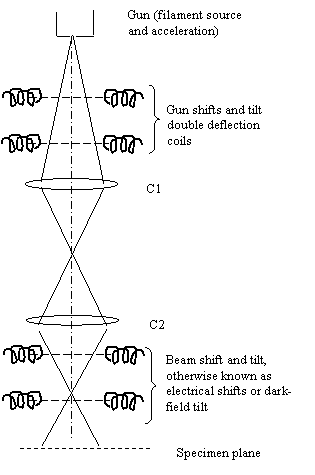
The topmost set of shift and tilt coils aligns the gun with
the first condenser lens, C1.
The bottom set of shift and tilt coils align whatever comes
out C2 with specimen plane and the rest of the electron
microscope.
Purists may argue that it's possible that C2 will sometimes
need to be aligned with C1, so surely there should be
another set of shifts and tilts between C1 and C2. That's
true, but in fact it's just not important enough for us to
worry about. In general, even though there are lots of
controls on an electron microscope, there are never enough
to do every alignment. Over the years, manufacturers have
realised that some alignments are not sensitive enough to
warrant correction coils, and this is one such example.
We have left out the condenser aperture for simplicity. It
is usually located in or below C2. Some microscopes have
two condenser apertures: another one being located in or
below C1. Often as a safety measure, it is not possible to
remove the condenser aperture entirely - this is because it
limits stray electrons that can hit the side of the
microscope and create excessive X-ray radiation.
Anyway, as far as alignment is concerned, lets just think
about what could go wrong physically with this system. Here
are some examples:
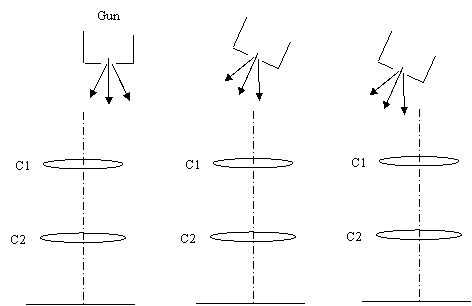
In the first picture, the electrons are coming out of the
gun in the correct direction (vertically downwards), but the
gun is in the wrong place: it is shifted to one side.
In the second picture, the gun is in the right position, but
the electrons are coming out at the wrong angle: the gun is
tilted.
In the third picture, the gun is both shifted and tilted.
In other words, it's a real mess.
Even if we align the gun perfectly with the condenser lenses
(which, for the sake argument, we assume are aligned with
one another), we still have to line up the condenser with
the next stage of the microscope: i.e. the specimen plane
and the object lens below it. These are some things that
can go wrong:
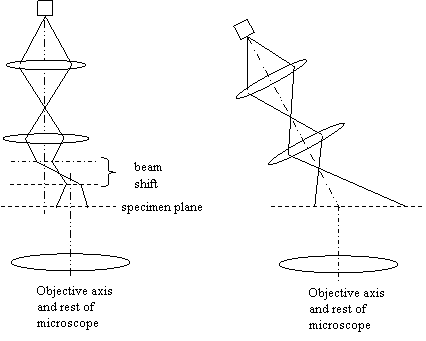
In the first picture, everything is okay, except condenser
system is shifted with respect to optic axis below the
specimen. This is an easy thing to solve, and we already
know how to do it - we adjust the electric shift knobs. If
you have forgotten about the shift knobs, ask the demonstrator to
point them out again.
In the second picture, the condenser system is illuminating
the specimen at an angle. Sometimes, we actually want to
make the microscope do this, especially when we are doing
what is called 'dark-field imaging'. However, for normal
'bright-field' imaging this an error which must be
corrected. We will learn how to correct it when we learn to
correct the 'current centre' of the objective lens, but that
comes later.
All this seems pretty complex. In fact, how we actually
correct all these variables is quite easy. Lets do some
experiments.
Ask the demonstrator: How do I change the strength of C1?
The demonstrator will show you a knob, or a computer control,
which is labelled 'spot size'.
Experiment: Adjust the C2 (the brightness knob) until you
see a neat disc. Check the condenser aperture is on-line by
making sure that the illumination goes in and out
symmetrically. Turn the spot-size knob and see what
happens.
All that happens is that as the spot goes up (i.e. C1 gets
stronger and stronger), the disc gets darker and darker. Is
this what we expect?
Well, not exactly. If all we were doing was increasing C1,
we would expect the ray diagram to go like this, as we
increase it from weak to strong:
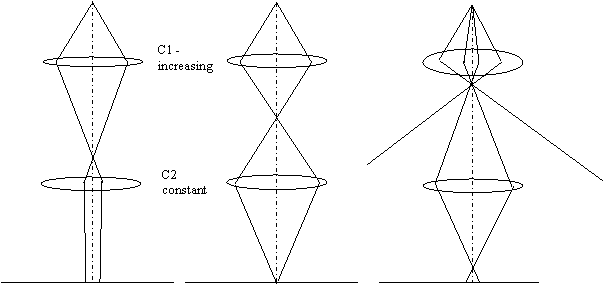
Look at what's happening at the specimen plane. Our disc of
illumination should get smaller and smaller, then reach a
cross-over, and then get bigger and bigger. Remember that
C2 is constant in this picture. Because it continues to bend
rays by the same amount, as the cross-over between the
lenses moves up the microscope, the cross-over below C2
moves (which to begin with is below the specimen plane) also
moves up.
In practice, you'll probably find that the disc stays the
same size. Why?
If you have a very old microscope, you will see the disc
change size, like above. However, a modern
microscope is often a bit clever. When you change the spot
size, which does indeed control C1, the computer in charge
of the microscope automatically weakens C2 a little bit, so
the illuminated area stays the same size. Cunning, but also
a bit confusing. Of course, you can still change C2 to your
heart's content by turning the brightness knob.
Experiment: Obtain a sharp image of the source by focussing
C2 so that you see a point of light on the phosphor screen.
Turn down the filament current slightly (as the demonstrator for
advice). You will begin to see a bit of structure in the
gun filament. Now change the spot size, but keep the
magnification at a constant setting. What's happening to
the image of the filament? Why is its magnification
changing? Think about the ray diagrams.
Can you think of a way of using different spot sizes to make
up a way of aligning the gun shift and the condenser shift?
Ask the demonstrator: Please misalign the gun shift slightly.
Tell me how to control the gun shift.
The control of the gun shift might be somewhere strange -
like on a tray that comes out of the microscope. Most
likely you have to do something to the computer by pressing
another button somewhere on the console, and then the 'gun
align' will be available on two new knobs you haven't used
before, which are labelled 'multifunction' knobs 'x' and
'y'.
You have now learnt about most of the important knobs on the
microscope. However, there aren't enough knobs to control
every bit of the electron microscope. The manufacturers
think that too many knobs frighten the punters. That's true
for most non-expert users. Expert users (which you can
become) can find this a bit tiresome, because you
continually have to change something on the computer to get
to control various bits and pieces. Any adjustments which
are regarded as a bit unusual (strangely, that includes some
of the most important adjustments - like astigmatism - which
we will do shortly) all have to be done on the multi-
function knobs.
Anyway, we now have control of the gun shift, the condenser
shift and the spot size. We can use these three controls to
align the both the gun shifts and the condenser shifts (that
is, the ordinary electrical shifts that we learnt about
right at the beginning).
This is what you do...
- Align a condenser aperture, as described in part 2.
- Turn up the spot size, watching the illumination on the phosphor screen. If it wanders off as you raise the spot size, bring it back to the centre with condensers shifts. Get up to a high spot size. (The actual value of a 'high spot size' depends on the type of microscope you are using: ask the demonstrator for advice).
- Now turn down the spot size to a low value, and centre the beam with the gun shifts (i.e. use the multi-function knobs).
- Repeat from (1), until you detect little or no movement of the beam from the centre of the phosphor screen.
Why does that line up the gun shift? Think about the ray
diagram. When the spot size is high, the cross-over below
C1 is close to the centre of C1: we now line up the specimen
plane (which equals the image plane, which equals the
phosphor screen plane, because we are not touching any other
lenses below the specimen plane) with the condenser system.
When the spot size is low (C1 weak) it magnifies any error
in the gun position, but in the case of C1 and C2 when the gun is
misaligned:
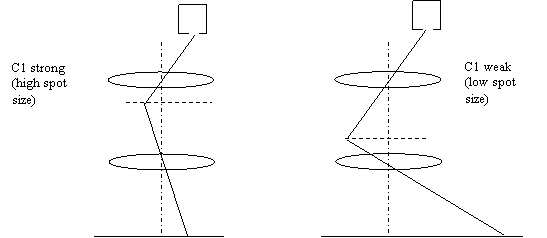
Because we know that the phosphor screen is reasonable well
lined up with the condenser lens C2, then getting the
illumination back to the centre of the screen with the gun
shift is mostly correcting the gun misalignment.
We iterate because C1 is never infinitely strong, so when
the gun is very shifted, the first adjustment is not
perfect. Also, there can be misalignment between C1 and C2:
this schema results in the best compromise of ending with
the beams going through the centres of both C1 and C2.
Now we know how to line up all the shifts in the condenser
system.
Ask the demonstrator: How do I adjust the gun tilt?
The demonstrator may say, "You're not allowed to change the gun
tilt". It's true that changing the gun tilt is not
something that every user should have to do on the
microscope. Once it has been set up, it should remain at
roughly the right setting. However, if the demonstrator does
allow you to touch it, you can try the next experiment,
which is not essential at this stage.
Experiment: Make sure the filament is saturated (i.e. at
its normal working value or filament limit), and just try
tilting the gun while you watch the illumination. It may
get darker or even disappear. Reverse whatever you did with
the tilt knobs (probably the multi-function knobs again) to
get the illumination back again.
When the gun is tilted (but is
still shifted on axis), then all that happens is that the
spread of electrons coming out of the gun misses the first
condenser lens, and so the illumination fades away. As a
first approximation, you can adjust and correct the gun tilt
by just making sure the illumination flux is at its maximum.
Summary: The condenser system consists of two lenses. We
can align the shift of the gun relative to the condensers,
and the shift of the condensers relative to the rest of the
optic axis by shifting the beam around with the gun shifts
and the ordinary condensers shifts (which are often just
called the 'beam shifts' or 'electrical shifts') while we
change the spot size (i.e. the strength of C1). We also
learnt how to adjust, very roughly, the gun tilt. All that
remains is to get the tilt of the whole gun and condenser
assembly going down the rest of the column. Then we will
know almost everything about the 'coarse' alignment of the
column. But first lets learn about an exceedingly important
kind of 'fine' adjustment…



Copyright J M Rodenburg
| 
